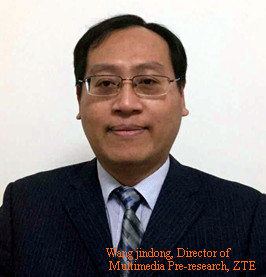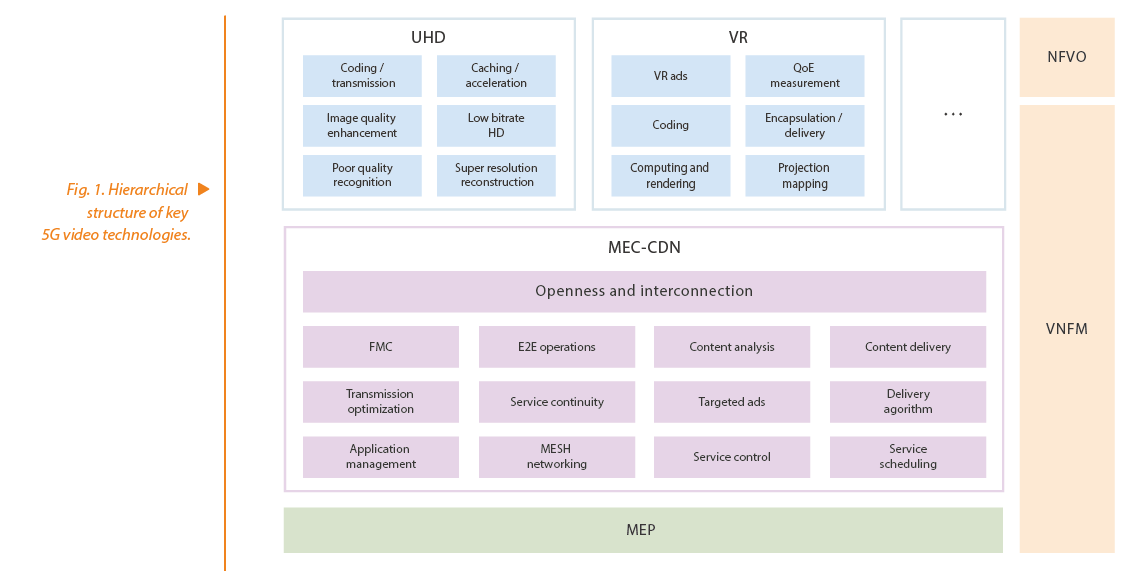Analysis of Key Technologies for 5G Big Video Development

5G network, featuring large bandwidth, low latency and massive connectivity, will bring users abundant new services and stimulate rapid development of existing services. Video services, with no doubt, will be a highlight of 5G applications. Among a variety of services, the most important video technologies are cloud virtual reality (Cloud VR), ultra high definition (UHD), and multi-access edge computing-content delivery network (MEC-CDN) that acts as the underlying support (Fig. 1).

Cloud VR
The VR technology can be divided into VR headend, cloud VR platform, and VR terminals according to its application locations in the VR service system. The VR headend involves mobile panoramic photography, panoramic sound, VR video stitching, toning (image noise-reduction, image sharpening, contrast enhancement, etc.), audio-video synchronization, content editing (watermark adding and cropping), just-in-time packaging (JITP), audio-video coding, push stream and local recording techniques. VR terminals include VR EPG and VR players. These terminals involve the asynchronous time warp (ATW) and asynchronous space warp (ASW) technologies. The cloud VR platform is the core of VR business operation. With high-bandwidth, low-latency networks and the MEC technology, the platform makes it possible to have VR contents based in the cloud and rendered in the cloud. The cloud contents can aggregate discrete contents and fully protect the interests of content providers, while the cloud rendering can make terminals lightweight, low cost, and easy for users to accept. The cloud VR platform involves the following technologies:
– Computing and rendering: Implement multithreading distributed computing and soft/hard rendering of VR videos and games by using edge-cloud resources such as vCPU and vGPU.
– Projection mapping: Convert three-dimensional spheres into the print media formats. The commonly used formats are cylindrical projection and polyhedral projection.
– Coding: The common traditional video codec formats include H.264, H.265, VP9, AOM's latest AV1 format (equivalent to H.265 compression ratio, open source, free of patent fees), ZTE's H.265S (complying with H.265, with 30% increase in compression ratio), and H.266 that may be released in 2020 (about 30% increase in compression ratio compared with H.265). The audio formats include AAC, MPEG-H, and 3D Audio.
– File/encapsulation: There are many container formats for VR contents, such as MP4 and FLV. The DASH format is usually used for encapsulation.
– Delivery: The transmission of VR traffic falls into full view transmission and field of view (FOV) transmission. The former refers to full transfer of VR contents, while the latter only transfers contents in the current field of the user’s view to the VR terminal. For weak-interactive VR services, full view transmission is usually used at the early stage of VR development. When VR resolution improves and its technologies and standards are mature, FOV transmission will gradually be used to save transmission bandwidth. The current VR transmission usually uses RTMP, RTSP, HLS, DASH, and FLV over HTTP protocols. Based on this, the mainstream protocols are extended for VR contents, such as HLS, DASH, and MMT. Since different terminals support different transmission protocols and DRM solutions, the VR-JITP technology is essential for compatibility with different terminals.
– VR advertisement: Advertisement is essential for commercial operation for video services. Current VR ads are produced in advance during content production. In the future, with the dynamic ads insertion technology at the service side, different VR ads will be presented for different users according to contents.
– QoE measurement: VR QoE measures the immersion quality and interactive quality. Immersion quality is measured through content quality and terminal presentation quality, while interactive quality is measured according to the degree of matching between the interaction and the feedback received by the user’s sensory channel. In general, VR QoE measurement involves video quality, audio quality, presentation quality, transmission quality, interactive quality, and experience quality. At present, China Video Experience Alliance, ITU-T SG-12, and VQEG are specifying VR QoE measurement standards and testing the product quality.
UHD
UHD technology is currently a hot research topic in codec formats, transmission protocols, segment caching, bitrate smoothing, performance enhancement, image quality enhancement, super-resolution reconstruction and poor quality recognition. ZTE has developed a unique low bitrate HD technology that can reduce bitrate by more than 30% compared with H.265 and offer visually lossless performance. The HD technology fully complies with the H.265 specifications, and terminal users have no awareness.
MEC-CDN
As MEC has been widely accepted in the industry, MEC-CDN will undoubtedly become a life-saving medicine for operators to get rid of the fate as pipeline providers and will also be their golden key to open the OTT market. The MEC-CDN technology involves:
– Networking: MEC-CDN implements dynamic self-networking as required. ZTE is the first in the industry to propose the MESH-CDN networking architecture that can effectively help operators address the issues of long uploading and uplink path and slow response time in the traditional CDN tree structure.
– Transmission optimization: The guarantee of video transmission QoS is especially important when a large number of users access the system at the same time. According to the network status feedback by MEC, CDN can combine with PCF, SDN and its own service capability (the slicing technology) to achieve congestion control and bandwidth balance of video transmission.
– Service continuity: Service continuity refers to seamless service migration when handover between fixed and mobile networks or between multiple MECs occurs. There are many solutions for seamless migration in MEC, but a complete solution has not yet been available for video business in the industry. It is easier to think of using the timeout connection reconstruction method that uses the terminal’s caching ability. However, this method may cause video stuttering that will affect user experience especially in live broadcast. After in-depth research, ZTE, for the first time in the industry, proposed a complete seamless migration solution for video services, ensuring the service continuity when users move across MEC-CDN.
– Content delivery algorithm optimization: Since MEC-CDN aims at a small number of users, the traditional content delivery algorithm needs to be further optimized. ZTE makes full use of the effective information provided at the MEC side, abandons the policy that delivers only based on content popularity, and takes into full consideration the user identity, trajectory, stay time and preference to build a content delivery prediction model based on user behaviors. This significantly improves the MEC-CDN cache hit ratio and reduces the upstream bandwidth cost.
– Content delivery: In addition to traditional OTT adaptive bitrate and protocol optimization, MEC-CDN needs to focus on the use of OTT multicast and further evolved multimedia broadcast multicast service (FeMBMS). ZTE is working with telecom operators to develop 5G live broadcasting solutions in venue.
With the leading position in the industry and rich technological accumulation, ZTE has rolled out its big video system to lead the development trend. In the upcoming 5G era, ZTE has also developed a full range of video products that can deliver complete and highly competitive solutions for individuals, enterprises and vertical industries, aiming to promote the prosperity of 5G big video industry.
[Keywords] Big video, Cloud VR, UHD, MEC-CDN, MESH-CDN, 5G era, live broadcasting